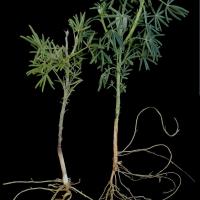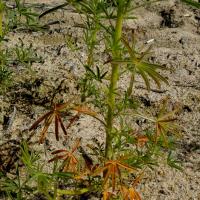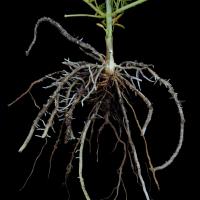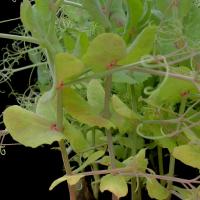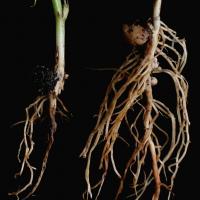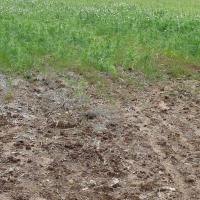Diagnosing waterlogging in narrow-leafed lupins and field peas
Waterlogging occurs when there is insufficient oxygen in the soil pore space for plant roots to adequately respire. Root harming gases such as carbon dioxide and ethylene also accumulate in the root zone and affect the plants. Narrow-leafed lupins are more affected by waterlogging than cereals.
What to look for
- Poor germination or yellow plants, in water collecting areas, particularly on shallow duplex soils.
- Bare wet soil and/or water-loving weeds present.
- Plants in waterlogged areas may prematurely die.
- Saline areas are more affected.
Paddock
- Waterlogged seedlings can die before emergence.
- Smaller pale plants with pale to bright orange-yellow leaflets on older leaves that are shed.
- Plants gradually die if waterlogging persists, or appear to recover then die prematurely in spring because damaged root systems cannot access subsoil moisture.
- Nodulation failure with poor nodulation, small, pale nodules or nodules may die with extended waterlogging.
- Waterlogged roots initially have reduced growth then turn brown and die. The plant often compensates with new roots emerging from the hypocotyl.
- Plants are more susceptible to root and foliar diseases, and may be more affected by aphids.
- Salinity magnifies waterlogging effects, with more marked stunting and leaflets on oldest leaf tip dying back from the tip.
Plant
What else could it be
| Condition | Similarities | Differences |
|---|---|---|
| Diagnosing nodule dysfunction in narrow-leafed lupins | Waterlogging is one cause | Other causes in non-waterlogged areas |
| Diagnosing potassium deficiency in narrow-leafed lupins | Smaller pale plants | Paleness less marked and leaflets drop leaving intact leaflets |
| Diagnosing allelopathy in narrow-leafed lupins | Reduced and staggered germination | Allelopathy affected plants remain malformed and stunted |
| Diagnosing nodule dysfunction in field peas | Waterlogging is one cause | Other causes in non-waterlogged areas |
Where does it occur?

Soil type
Damage is worse in the following situations:
- Areas affected by secondary salinity. Germination and early growth can be much worse on saline areas after waterlogging events.
- Water accumulating or poorly drained areas such as valleys, at the change of slope or below rocks.
- Duplex soils, particularly sandy duplexes with less than 30cm sand over clay.
- In very warm conditions when oxygen is more rapidly depleted in the soil.
Management strategies
- Avoid growing narrow-leafed lupins and field peas on regularly waterlogged soils. In the case for lupins these areas often provide focal points for bean yellow mosaic virus infection and diseases such as sclerotinia and brown spot.
- Drainage may be appropriate on sandy duplex soils on sloping sites.
- Raised beds are more effective on relatively flat areas and on heavier textured soils, but areas need to be large enough to justify machinery costs.
How can it be monitored?
- Plants can be waterlogged when there is a watertable within 30cm of the surface and no indication of waterlogging at the surface. Water levels can be monitored with bores or observation pits, but watertables can vary greatly over short distances.
- Observe plant symptoms and paddock clues and verify by digging a hole.
- The salinity status of a soil can be assessed from indicator plants, measuring the salt concentration in soil samples or with electromagnetic-induction instruments, or by measuring the depth to a saline watertable.
See also
Page last updated: Tuesday, 11 July 2017 - 1:09pm



